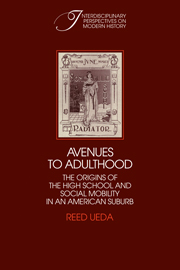Book contents
- Frontmatter
- Contents
- Acknowledgments
- Introduction
- 1 Farm village to commuter suburb
- 2 The evolution of educational leadership
- 3 The free high school
- 4 The rise of Yankee city and the prolongation of schooling
- 5 Popularizing high school: “the college of the people”
- 6 The origins of high school youth culture
- 7 Educational opportunity and social mobility
- 8 The birth of progressive reform and the junior high school
- Conclusion: The high school in the light of history
- Appendix I Courses of study
- Appendix II Sources and methods
- Appendix III Students and households
- Appendix IV Supplementary household data
- Notes
- Index
- Frontmatter
- Contents
- Acknowledgments
- Introduction
- 1 Farm village to commuter suburb
- 2 The evolution of educational leadership
- 3 The free high school
- 4 The rise of Yankee city and the prolongation of schooling
- 5 Popularizing high school: “the college of the people”
- 6 The origins of high school youth culture
- 7 Educational opportunity and social mobility
- 8 The birth of progressive reform and the junior high school
- Conclusion: The high school in the light of history
- Appendix I Courses of study
- Appendix II Sources and methods
- Appendix III Students and households
- Appendix IV Supplementary household data
- Notes
- Index
Summary
The fledgling suburb of Somerville entered the wave of secondary-school reform sweeping Massachusetts before the Civil War, when the town meeting voted with “complete unanimity” in 1850 to prepare the establishment of the first Free Public High School. The record of a unanimous vote for the high school in Somerville contrasts sharply with opposition to the institution in nearby Beverly, Massachusetts, later in the decade. Were the townspeople enthusiastically united behind the high school, or could Somerville's unanimous vote have reflected a consensual deference to the will of the selectmen and school committeemen, a symbolic act affirming communal respect for leadership, as in colonial town politics? The question is germane, for evidence of underlying friction exists. The remarkable George L. Baxter, who was headmaster of the high school from 1867 to 1911, recalled, “It required strong, persistent efforts by friends of education to overcome the reluctance of the people to tax the entire community for the higher education of a small portion of it.”
Unfortunately, no contemporaneous records of individual voting survive to shed more light on these issues. Thus, to proceed to a closer analysis of popular support for the high school, this study perforce focuses on the period of operation immediately after its establishment. It also depends on an examination of the characteristics of students and their families to assess the basis of sponsorship for secondary schooling. Nevertheless, these social data probably reveal more about deep-seated popular attitudes toward the high school than a single act of voting.
- Type
- Chapter
- Information
- Avenues to AdulthoodThe Origins of the High School and Social Mobility in an American Suburb, pp. 40 - 58Publisher: Cambridge University PressPrint publication year: 1987

